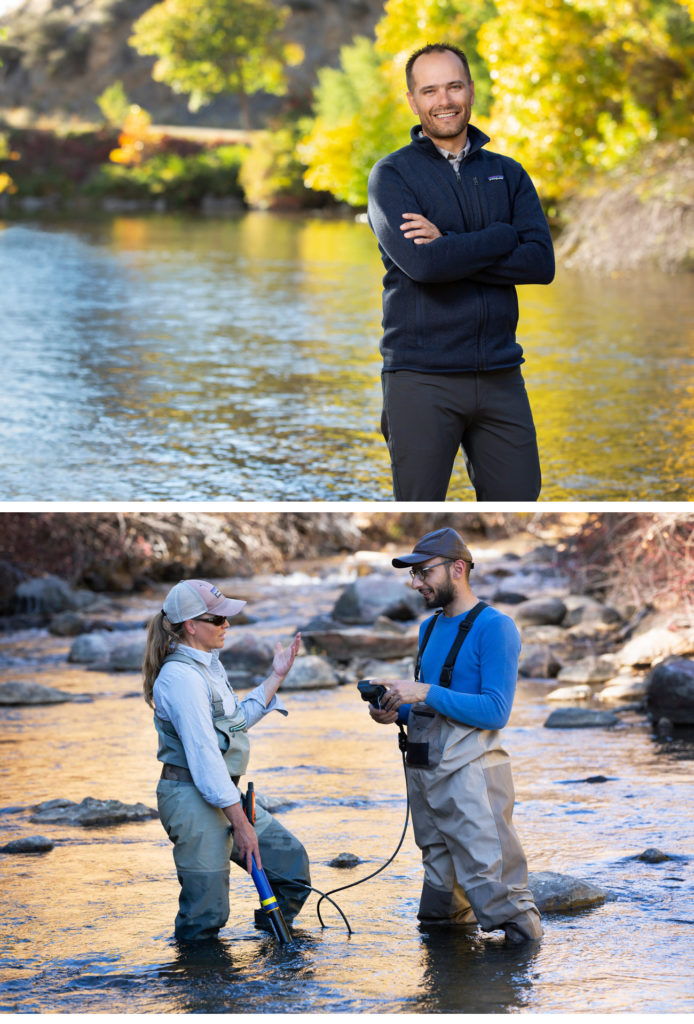Measure to Manage — With Better Water Data

It might come as a surprise that the water stores we assume are so carefully measured and divided are not always precisely accounted for or understood.
Sure, there are useful methods for tracking supply and demand like measuring mountain snowpack and metering residential and agricultural flows. But given the West’s increased focus on water conservation, experts on the front lines of our water worries say we’ve left out an important part of the discussion: huge swaths of data about water supply and demand are missing.
Utah State University researchers are working to change that. Jeff Horsburgh ’99, M.S. ’01, Ph.D. ’09 and Bethany Neilson ’98, M.S. ’01, Ph.D. ’06, professors of civil and environmental engineering with joint appointments at the Utah Water Research Laboratory, are leading multiple research initiatives with a focus on water data. Their collaborative studies are designed to improve data collection methods to better account for water supply and demand while improving available tools for managing and sharing water data. The goal is to use these data to generate important new insights and improve decision making among water managers and users.

Neilson leads the Logan River Observatory, or LRO, a system of hydrologic monitoring stations throughout the Logan River watershed. LRO is a test bed for collecting detailed, long-term hydrologic data needed to inform water policy and management decisions. Neilson and her colleagues have spent a decade building the observatory, securing more than $3.5 million in research funding in the last three years. The project has led to partnerships with stakeholders, including USU and two other universities, the Utah State Legislature, the Utah Division of Water Resources, Logan City, and the Cache Water District. Recent LRO studies focus on measuring the impacts of changing snowpack on water availability and understanding the effects of micro-plastics in relatively pristine watersheds.
“The network of hydrologic sensors in the Logan River Observatory spans remote, mountainous terrain, urban and agricultural portions of the watershed,” says Neilson. “With nearly a decade of data at some locations, we have a unique opportunity to study detailed hydrologic controls, to understand human influences and test new water management approaches. This work is critical in addressing Utah’s increasing water shortages.”
One of the challenges in managing and sharing the large volume of data collected from systems like the LRO is the need for robust cyberinfrastructure. Earlier this year, USU — led by Horsburgh — joined the University of Alabama and other partners to form the Cooperative Institute for Research to Operations in Hydrology, or CIROH, which will receive up to $360 million in federal funding over the next five years in partnership with the National Oceanic and Atmospheric Administration. As a founding member, USU will receive several grants to oversee CIROH projects, the first of which is all about water cyberinfrastructure. One such project is the development of an operational hydrologic information system that will support the day-to-day collection and management of water data with a new ability to share data in standardized formats. This realm of hydrologic data science is so new, its name may be unfamiliar to some. Hydroinformatics is the nascent discipline focused on developing the cyberinfrastructure needed to collect, store, and disseminate actionable water data.

As the Western U.S. falls deeper into drought and severe flooding impacts communities in the East, the need for smarter water management strategies has reached a critical point. Both Horsburgh and Neilson agree that important steps in making better decisions about water include collecting more relevant data and creating robust water data management systems.
“I’ve heard so many people say ‘you can’t manage what you don’t measure,’” says Horsburgh. “I fully believe this. But I also know that better tools lead to better data and that we can’t realize the full value of those measurements if nobody knows about them. With a total of 30 streamflow gages, water quality monitoring sites, and climate stations that collect continuous data, the Logan River Observatory is a perfect use case for testing these tools.”
Horsburgh is quick to credit those who built the first iterations of water cyberinfrastructure. One such system operated by the U.S. Geological Survey tracks conditions in select waterways around the country. And while that technology is the premier hydrologic data system in the U.S., it doesn’t accept data inputs from other sources. Horsburgh says a complementary system is needed to enable access to data collected by organizations like the LRO.
“Water data are collected every day all over the country,” he adds. “However, most of us who collect hydrologic data struggle with the day-to-day management tasks required to collect and share high-quality data products. We don’t have a common set of tools or standards for collecting, storing, or sharing that data, which limits what we can do. A national-scale hydrological information system will help with data access.”
A fully functional, national-scale system is still several years away, but the USU team has already taken important steps in defining what such a system will look like, with the LRO serving as the proving ground.
“We aren’t starting from scratch in building this cyberinfrastructure,” says Horsburgh. “The ideas and technologies we’ve already developed, along with our strategic partnership with the Logan River Observatory, put us in a great position to realize a national-scale hydrologic information system very soon.”
By Matt Jensen ’08
Photos by Matt Jensen






